Photo
album: "The birds that fly"
Fly
over a photo with the mouse to enlarge it
Click
on a photo to open it in a new window
There
are not only penguins in the Antarctic, there are also birds that can fly and
that come to reproduce, during summer, in archipelago Pointe Géologie. Those
birds are members of two families: in the first one, there is only one single
species closely related to the gull family, the Antarctic skua; and in the other
one, there are different species of petrels: We have already met the Antarctic
giant petrel (the larger). There are also: the snow petrel, the Antarctic
fulmar, the Cape .petrel, and the smaller one the Wilson's Storm Petrel. Then,
since the stay of Thala Dan during her first rotation to Dumont d'Urville base
is drawing near its end, a strange metal bird will embark Paul-Émile Victor,
the director of Expéditions Polaires Françaises (French Polar Expeditions) to
fly him over to the ship.
 |
The Antarctic skuas are birds
closely related to the gull family. They are fiercely predators for eggs
and chicks of other bird species including Adélie penguins. However the
presence of man has somewhat modified their way of living. They found it
easier to feed on kitchen garbage than to chase other birds. As a
consequence their duration of stay on Pétrels island has increased in a
non-negligible way.
(Note: This must have changed now that garbage is no longer thrown away
to sea.) |
 |
The skua defends its nest with much
conviction, when there are chicks in it. It begins to shout, rising its
wings, as on the photo. Then it takes off on flight and dives straight for
the intruder's head at great speed, and modifies its flight at the last
moment to brush him with its wings. It can even takes his hat away with
its claws. A thing very impressive. |
 |
Skua in flight. Its wingspan can
reach 140 centimetres. |
 |
The common feature of the different
families composing the procellariiformes order (which includes the petrels)
is their nostrils enclosed in one or two tubes above their bills. The Cape
petrel has a maximum wingspan of 91 centimetres. |
 |
To defend its nest, the Cape petrel,
like many other petrels, spits on the intruder a foul-smelling, yellowish
oil coming from its stomach. When the biologist come back from a visit to
petrel's nests, he is expected to remove his work clothes before entering
a room where other members of the expedition are staying! |
 |
The Antarctic fulmars have a
maximum wingspan of 120 centimetres. |
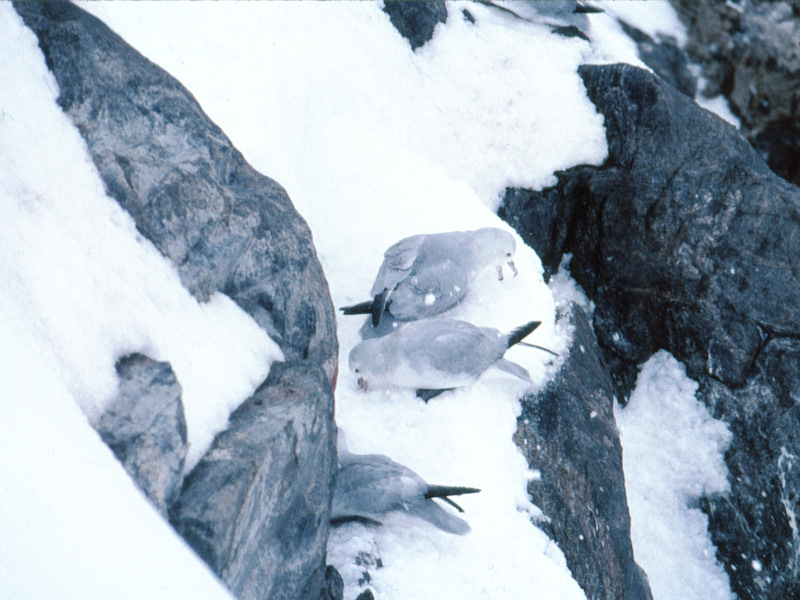 |
Fulmars have their nests on sheer
rock faces. As there are very few fulmar couples on the islands the area
near their nests is a protected zone. |
 |
A couple of snow petrels. |
 |
A snow petrel on its nest under a
rock. Its maximum wingspan is 95 centimetres. |
 |
Wilson's storm petrels. They go out usually in the evening, therefore they
are difficult enough to photography. Their maximum wingspan is 42
centimetres. They are the greatest travellers amongst birds. They come to
reproduce in Antarctica during the Antarctic summer and, during winter,
that is during the northern hemisphere's summer, they fly over to the
Arctic to feed. They can travel forty-thousand kilometres a year, like a
trip around the Earth.
|
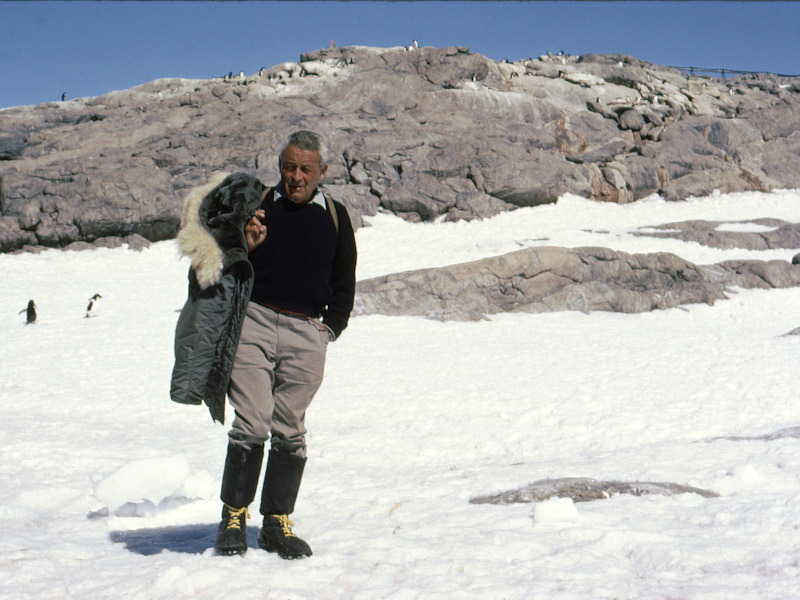 |
Let us leave the birds, and
introduce Paul-Emile Victor to you. He founded and heads the Expéditions
Polaires Françaises. He is more familiarly called PEV. As every year, he
has come with the first rotation of the ship to supervise the different
operations. |
 |
PEV, surrounded with Adélie
penguins, takes a last walk around Pétrels island before embarking in the
helicopter which will fly him over to Thala Dan. On foreground, at right,
Jean-Pierre Jacquin (Racea) and in the back, Pierre Sandron (power
station's electrician), together members of our expedition. |
 |
Thala Dan's captain is embarking on
one of the boats that will transport him back to his ship. André Santu
(Magne), on foreground, take a picture of him. |
 |
Another Thala Dan's boat is moving
away with, aboard, two people of our expedition : André Coiffard (radio
operator), foreground left, and , foreground right, Fernand Ginter (our
base engineer). |
 |
The helicopter has just landed and
PEV is stepping aboard, followed by two members of the eighteenth
expedition, the second of them being Fernand D'Amato responsible of that
mission. On foreground, Bernard Pelluard (Cinoc of our mission). |
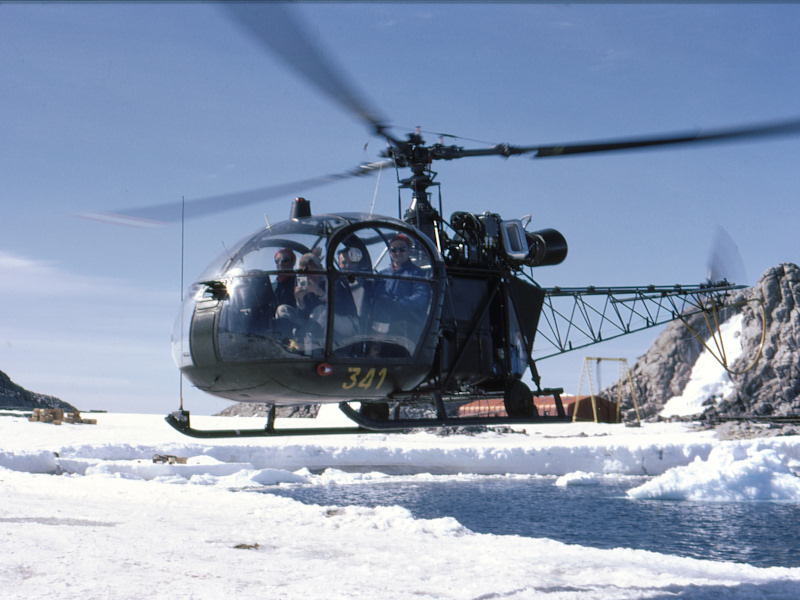 |
Paul-Émile Victor, sitting left of
the pilot, is taking pictures while the helicopter takes off. Behind him,
Fernand D'Amato. |
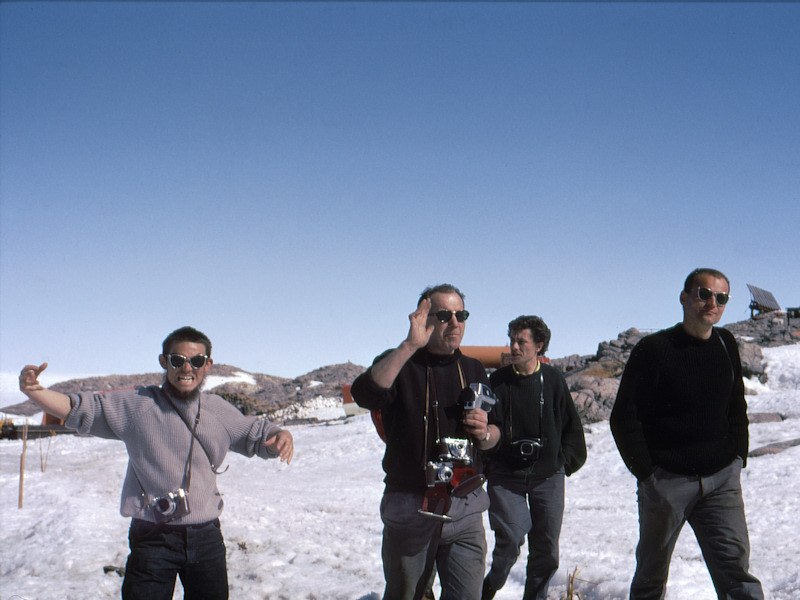 |
A few members of our expeditions
are waving farewell to the helicopter which is flying away with its
passengers. From left to right: Jean-Pierre Jacquin, Pierre Sandron,
Bernard Pelluard and Paul Thiébaud (our vehicle mechanic). |
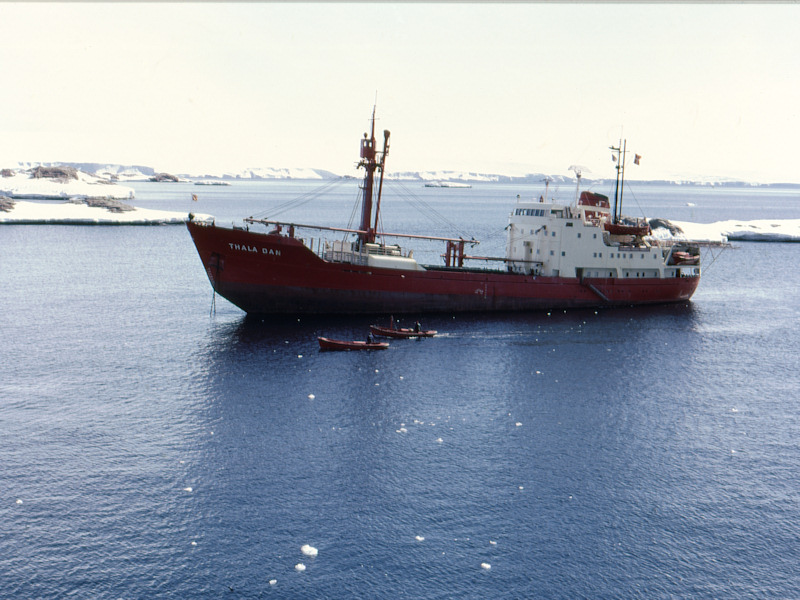 |
Thala Dan is about to depart,
headed to Melbourne where passengers will disembark. We will see her only
at the end of the summer campaign. In the meantime, she will make a
rotation to one of Australian expeditions' bases. She will go back to
Melbourne, at the end of that rotation, then she will make the second and
last rotation of the season to Dumont d'Urville. |
Go
back
.
.
.
.
.
.
.








